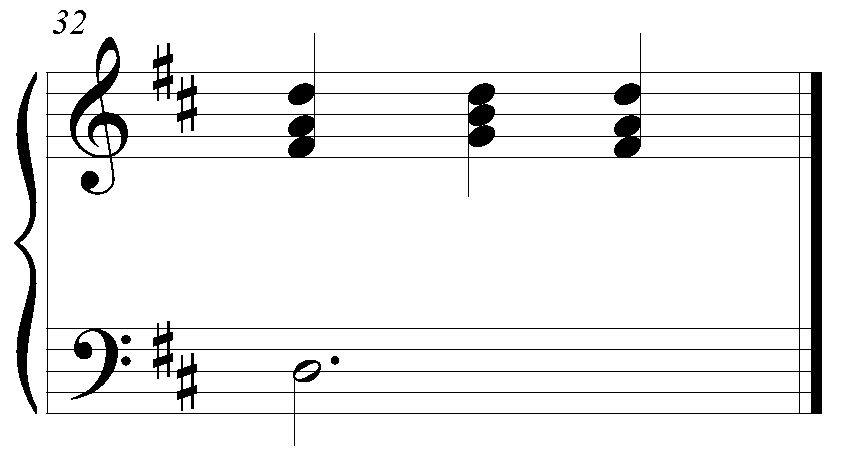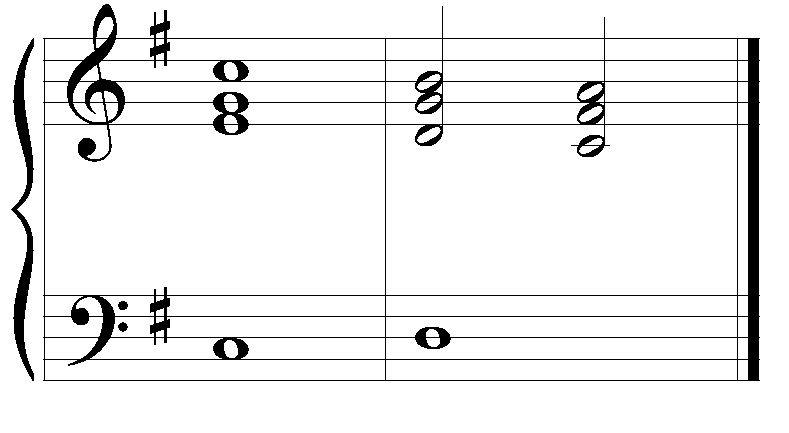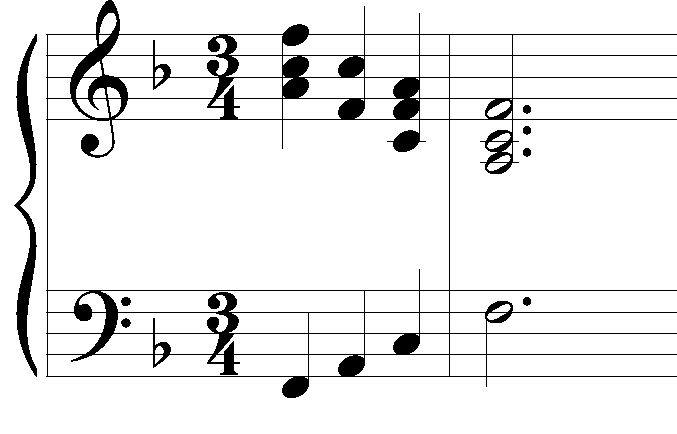|
Six-four Chords
Second inversion triads are the most restricted type of chords in music theory. Other kinds of triads have quite a bit of flexibility about their doubling and voice leading, but not six-four chords.
Basically, they operate according to rather rigid formulas, much as non-chord tones do. They must be approached in a certain way, and resolved in a certain way, like the non-chord tone of the same name. Many theorists do not actually consider second inversion triads as actual chords in their own right - they are considered dissonances that are in the process of resolving to the main chord in the analysis. Either way you think about this, it is important to know how to move the voices properly. There are two specific doubling and voice leading rules for these six-four chords that you should always keep in mind:
Doubling - the fifth is always doubled
Voice leading - in general,six-four chords are approached and resolved by stepwise movement
There are three types that behave like non-chord tones – the passing 6/4, the pedal or neighboring 6/4, and the cadential 6/4 – as well as the simple use of an arpeggiated 6/4, all of which we will study below:
The Passing six-four:
This type of 6/4 chord is used much like the non-chord tone called a passing tone. The bass note of this six-four chord behaves just like a passing tone - in other words, this bass note, the note before it, and the note after it will make a three note stepwise line, either ascending or descending.
A simple way to create a passing six-four chord is to take a chord and its first inversion; my example uses I and I6, but you may use any diatonic chord and its first inversion. Then fill in the gap of a third in the bass between these two chords with a passing tone. That note will be the bass note for the 6/4 chord. Since the passing note in this example turns out to be the second degree of the scale, the 6/4 chord we need to use will be a V. IN this progression, the other voices move predictably also. One of the upper voices will follow a similar passing tone movement in the opposite direction from the bass line, one will remain stationary, and one will move like a neighbor tone. Doubling and voice leading should follow the two rules above.
Example: I V64 I6

The Pedal or Neighboring six-four:
In this type of 6/4 chord, the bass note sustains like a pedal tone, or conversely you might say that two of the upper voices behave like neighbor tones. With a pedal six-four, the bass stays on the same note for three chords in a row - the six-four chord is the middle chord of the three. The bass note is doubled in all three chords.
In the example below, I chose the tonic note as my pedal tone. IN this type of 6/4 chord, the first and third chords are usually the same root position chord. That root position chord will have its root doubled, and that pedal note will also be doubled in the middle chord. This pedal noteis the fifth of the second chord. In the example below, the middle chord is a IV 6/4 chord, since the tonic pedal note is the fifth of the IV chord. You can use other tones of the scale as your pedal, not only the tonic note. Pedals on the dominant and tonic notes are quite common. If you notice the voice movement in the example below, you will observe that two voices hold stationary on the pedal note D, and the other two voices move and down a step to create upper neighbor tones. This is typical of this type of six-four chord. Doubling and voice leading should follow the two rules above.

Example: I IV64 I
The Cadential six-four:
This type of 6/4 chord behaves like an appogiatura - it falls on a stronger beat than the chord of resolution, and upper voices resolve downwards by step. It may be approached by a leap but is often approached by step in the bass. The cadential 6/4 chord is always a tonic six-four, and the resolution chord is always V or V7. The approach chord is variable, but the bass often approaches by step, moving upward from the 4th scale degree. I use a IV chord for the approach in the example below. Another common approach chord is a ii6.
Notice that the 6/4 chord occurs on a strong beat, in this case on the downbeat, and while the bass remains stationary, upper notes resolve downward by step to the V. When the chord resolves to V, two upper voices move down by step, and when it moves to V7, all three upper voices move down stepwise. When approaching with a IV chord, as below, the upper voices generally make a stepwise downward movement in all three chords. The sound of this type of cadence is very distinctive with its descending motion, and it occurs frequently in tonal music.
 
Example: IV I64 V IV I64 V7
Arpeggiated six-four chords:
These are chords where the bass is arpeggiating the SAME triad. Since there is no change of chord here, there is no worry about approach or resolution, and leaps are fine. The notes are just moved around on the same chord, and at a certain point, the fifth of the chord might occur in the bass, making a 6/4 chord. This type of 6/4 chord can be used without the above restrictions on leaps or doubling, since it is the same chord throughout.

Example: I I6 I64 I |
